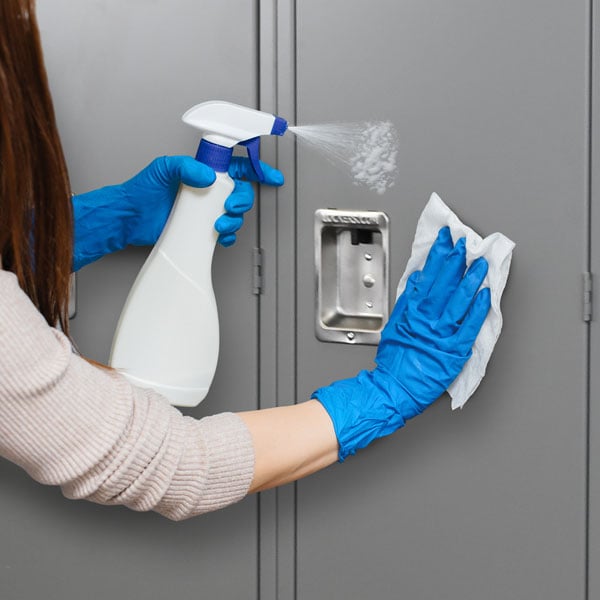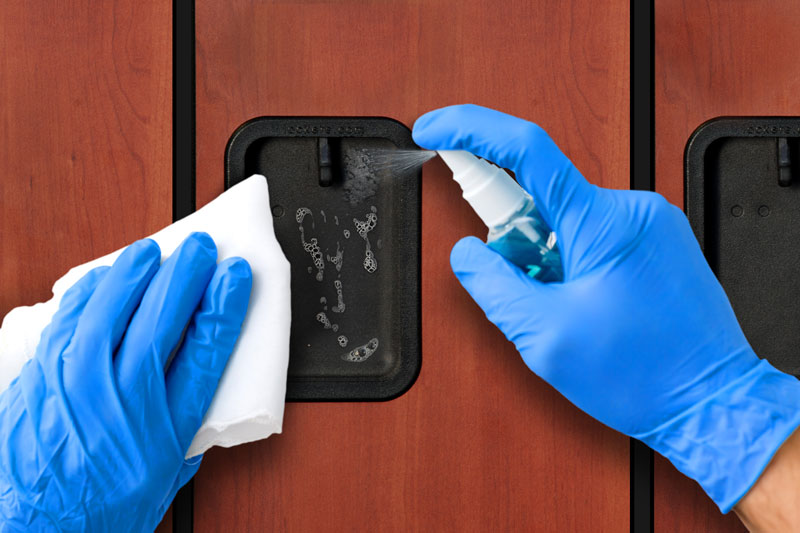How to Clean Your Lockers
February 22, 2024

If you want to keep up the appearance and functionality of your Salsbury lockers, you must clean them regularly. You should use proper cleaning techniques to preserve the aesthetic of both the interior and exterior of the locker.
When cleaning your locker, you must be careful not to cause any damage. There are different methods to keep in mind when you clean lockers made of different materials. In this guide, we will discuss steps to clean metal, wood, and plastic lockers.
Metal Lockers
1) Gather cleaning supplies, which will include a soft cloth or sponge, liquid soap, detergent, or diluted water-soluble household cleaners. Make sure to avoid abrasive applicators, abrasive cleaning agents, cleaners containing chemical detergents, or cleaners with acid content. These can cause damage like discoloration, scratching, or even remove the finish from the locker.
2) Before you begin to clean the locker, test out the cleaning solution on an inconspicuous area of the locker. This will help to ensure that the solution doesn’t negatively impact the locker’s finish.
3) Dampen the soft cloth or sponge with your cleaning solution. Carefully wipe the interior and exterior surfaces of the locker. Pay special attention to any visible dirt or stains. A circular motion is effective for removing grime. Make sure not to be too rough, since this can damage the locker’s finish. If you come across particularly stubborn stains or dirt, try using a soft-bristled brush or an old toothbrush to scrub the affected area. This method, unlike applying too much pressure or using abrasive materials or cleaners, can help remove dirt without damaging the locker’s finish.
4) Rinse the locker with water to remove any residue from the cleaning solution. This is an important step since it will prevent any chemical buildup that might cause damage to the locker over time.
5) Use a clean soft cloth to completely dry the locker, since moisture left on the locker’s surface can lead to rust or mold. Make sure to dry crevices or corners where water may accumulate.
Wood Lockers
1) Gather cleaning supplies, which will include a soft cloth and the wood-cleaning product of your choosing. Make sure to avoid wood-cleaning products that contain ammonia, silicon-based ingredients, vinegar, or wax. Such ingredients can dull the wood and even lead to splitting or peeling.
2) Wipe down the locker with your soft cloth and wood-cleaning product. For any particularly sticky or dirty areas, you can combine warm water and a cleaning detergent and clean with a soft-bristled brush. As with metal lockers, you need to be sure that the cleaning solution isn’t too strong since that can damage the look of the locker. Using distilled water to dilute the solution can help to avoid risk.
3) To combat water spots (a common issue with wood lockers), apply a small amount of mineral spirit to the affected area and gently wipe them away in circular motions using steel wool.
4) A simple wipe-down is sufficient for everyday cleaning, but every few months you’ll want to do a detailed cleaning to really get into those hard-to-reach nooks and crannies.

Plastic Lockers
1) Gather your cleaning supplies, which will include a soft cloth and a mild liquid soap. Avoid abrasive powder or scouring pads, ceramic tile cleaners, solutions that contain enzymes, solutions that contain acids or lye, or solutions that contain more than 1% by volume of ammonia.
2) Dampen your soft cloth with the mild liquid soap. Wipe down the interior and exterior of the locker.
3) Rinse the locker with water. Thanks to their durable plastic structure, you can hose plastic lockers down without worrying about damaging them.
4) Thoroughly dry the locker.
Just by following these simple steps, you will be able to clean your metal, wood, or plastic lockers without damaging their finish. If you regularly clean and maintain your lockers, they will not only look presentable and clean but you will be extending their lifespan. Check out Salsbury’s high-quality metal lockers here, wood lockers here, and plastic lockers here.